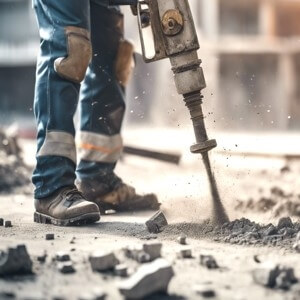Breaking out concrete Risk Assessment

A comprehensive Risk Assessment for breaking out concrete.
Breaking out concrete refers to the process of breaking or demolishing concrete structures for various purposes, such as removing sections, repairing damage, or preparing areas for new construction projects. This process often involves specialised tools designed to efficiently and effectively fracture and remove concrete materials.
Commonly used equipment includes jackhammers, which deliver rapid strikes to break up the concrete, and demolition hammers, which provide greater force for larger tasks. For smaller, more precise projects, traditional tools such as a sledgehammer paired with a cold chisel can be used to chip away at the concrete surface.
Additionally, safety precautions are crucial during the concrete-breaking process, as it can generate dust and debris that pose hazards. Therefore, wearing protective gear such as goggles, gloves, and respiratory masks is highly recommended. This method is a crucial aspect of many construction and renovation projects, facilitating necessary repairs or structural modifications in various settings.
This document is:
- Recognised by local authorities
- Recognised by principal contractors
- Suitable for CDM sites
- Approved by H&S managers
It increases your chance of winning tenders and has been written by trained health and safety professionals.
If you want others to have confidence in your company, download and buy the proper documents today.
As with all our documents, our risk assessments are in Word™ format, available for instant download and use, and only need to be bought once.
Once you buy and download this document, it’s yours to keep and use for life.
Download it today, put your company details on it, and use it immediately.
Give people confidence in you, your company, your products and services.
Some sample text from this document reads:
'Slips, trips and falls'
• Operatives or the public could suffer sprains, fractures, and tissue damage from slipping, tripping, or falling over tools, materials, waste, or areas of bad ground.
• Good housekeeping is maintained at all times
• Waste materials to be bagged or skipped as work progresses
• Work area to be cordoned off where possible, and use of site signage
Supervisor to brief operatives on safe working practices, housekeeping and the dangers on site of slips, trips and falls before works commence
Why not browse the HSEDocs catalogue of method statements, risk assessments, COSHH assessments, or industry-specific packages?
GET THIS DOCUMENT
£8.99+VAT
- Available in Word™
- Fully customisable
- Add your Company Logo
- UK & EU Compliant

 CART
CART 